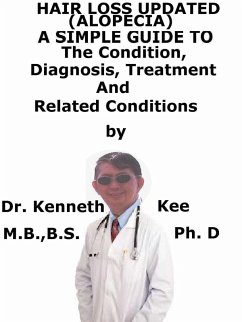Hair Loss (Alopecia) is the partial or total loss of hair in the scalp, armpit or other areas of the body to the extent that the bare skin is evident and sparse amount of hair is present or totally absent.
Hair loss normally happens gradually and may be patchy or diffuse (all over)
The most frequent types of hair loss are:
1.Male pattern baldness or androgenetic alopecia.
Its causes have been linked to genes, hormones and age.
Other types of hair loss are:
2.An auto-immune condition known as patchy hair loss (alopecia areata),
3.Temporary hair loss (telogen effluvium),
4.Compulsive hair pulling (trichotillomania) and
5.Traction alopecia.
Diagnosis
A scalp biopsy may be performed.
Blood tests may also be done to check for autoimmune disorders and thyroid problems.
The diagnosis is typically based on the normal appearance of the bald patches.
If there is disbelief about the cause of the hair loss, occasionally some blood tests or a skin scraping from a bald patch may be done to exclude other causes.
A small sample (biopsy) of skin is occasionally taken to look at under the microscope.
Treatment
If hair loss is not prevalent, the hair will often re-grow in a few months without treatment.
For more serious hair loss, it is not clear how treatment can assist to alter the course of the disorder.
Frequent treatments may be:
1.Steroid injection under the skin surface
2.Medicines applied to the skin
3.Ultraviolet light therapy
4.The wig may be utilized to hide regions of hair loss.
Watchful waiting or not treating is a frequent first treatment.
One method for treating alopecia areata is by getting corticosteroid injections from a dermatologist.
Reports show that patients normally notice hair growth about 30 days after the injections.
2 medicines Finasteride and Minoxidil work by stimulating the re-growth of hair in hair follicles.
Combinations of Finasteride, Minoxidil and Ketoconazole are more effective than individual use, indicating synergistic effects of the medicines.
Surgery:
A hair transplant done by a surgeon is a surgical treatment to transferring growing hair from one part of the head to another.
Scalp stem cells
In 2012, research teams cultivated human scalp cells and produced hair follicle cells.
When the hair follicle cells were transferred to the backs of hairless mice, hair began to sprout.
The latest development requires producing equipment that permits for more efficient mass production of such hair follicle cells.
1. RCH-01
Replicel's hair growth treatment, RCH-01, requires culturing a person's own hair follicle cells and then re-injecting them back into their scalp.
2. Trinov aka the Brotzu Lotion
A lotion discovered to grow hair while treating vascular insufficiency in patients with diabetes
3. Setipiprant
Setipiprant is an oral medicine or pill, easy to give and treat.
4. HSC660 is an injectable serum that is given to stimulate the growth of new hair follicles and existing ones in a person's scalp.
5. RT1640 is made of minoxidil, cyclosporine-A, and a novel molecule RT175
100% of the people who utilized the treatment had good hair growth in phase1
6. SM04554 is a small-molecule topical solution that triggers the Wnt pathway to grow hair.
7. Breezula is a topical anti-androgen produced for the treatment of AGA, unlike other anti-androgens observed which stop the body's production of DHT,
8. FOL-S-005 main peptide of Follicum is being utilized to activate hair growth
Many other discoveries are ready for marketing in 2019
Read about hair care and other new hair remedies in the book
TABLE OF CONTENT
Introduction
Chapter 1 Hair Loss
Chapter 2 Diagnosis and Hair Care
Chapter 3 Treatment of Hair Loss
Chapter 4...
Dieser Download kann aus rechtlichen Gründen nur mit Rechnungsadresse in A, B, CY, CZ, D, DK, EW, E, FIN, F, GR, H, IRL, I, LT, L, LR, M, NL, PL, P, R, S, SLO, SK ausgeliefert werden.


